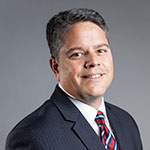Newton’s First Law of Motion states that an object at rest stays at rest, and an object in motion stays in motion. Eduardo Conrado is the latter object. Literally and figuratively, he’s spent his life so far in a state of perpetual movement—across disciplines, business units, and even geographies, all of which has prepared him perfectly for his current role as senior vice president and chief innovation officer of Motorola Solutions, a spinoff of former parent company Motorola Inc. Motorola Solutions provides telecommunications products for enterprise and government clients.
“I began working at Motorola twenty-three years ago and worked my way up,” Conrado says. “It doesn’t feel like that long. Time flies.”
Newton’s law states every act of motion begins with an external force. For Conrado, that initial force took place not when he joined Motorola, but when his family moved to the United States from Nicaragua in 1978. “There was a civil war in Nicaragua, so we moved to the United States when I was in junior high school,” recalls Conrado, who subsequently studied industrial engineering at Texas Tech University. “My first job was as an industrial engineer at Texas Instruments, where I designed manufacturing lines for one of their sites. When I was there, however, I realized I wanted to branch out into more of a business or marketing role.”
Conrado decided to pursue his interest in marketing in 1989 when he enrolled full-time in the MBA program at Thunderbird School of Global Management in Glendale, Arizona. “I had come from Latin America and lived in the US, but I was most interested in learning more about Europe. So while I was at Thunderbird, I applied for a program to get a second MBA at ESADE [Business School] in Barcelona,” says Conrado, who studied marketing at Thunderbird and finance at ESADE. “I met my wife at Thunderbird, and she moved to Barcelona with me. After I graduated, we moved for a year and a half to Norway, which is where my wife is from, and that’s where I got hired at Motorola.”
Conrado subsequently moved back to the US and commenced an international career in market research, analyzing opportunities for Motorola in Latin America, Asia, and Europe.

“For the first ten years of my career, I moved around every one or two years to a different business unit within Motorola,” says Conrado, who cites as a particularly memorable assignment his stint on Motorola’s joint ventures team. The team is responsible for seeding technology startups around the world in order to accelerate uptake of Motorola’s solutions. After a spell working for one such startup in Argentina, Conrado joined the product marketing team at Motorola’s Chicago headquarters, where he made his mark aggregating and unifying disparate marketing functions.
“When I moved to Chicago, marketing was a distributed function. Motorola had no chief marketing officer (CMO), but I felt we could do a better job positioning the company if all our marketers reported to a single marketing head,” Conrado says. “De facto, I became the head of marketing for all the company’s B-to-B businesses.”
When Motorola, Inc. split into two businesses—B-to-B-focused Motorola Solutions and consumer-focused Motorola Mobility—in 2011, Conrado became chief marketing officer of the former prior to assuming his present position as senior vice president and chief innovation officer in January 2015.
“Everything I’ve done previously has led up to this,” says Conrado, whose constant forward motion—from engineering to marketing; from one line of business to the next; and from Latin America to the United States and Europe—has made him an innovative thinker by design. “When you move internationally at an early age and continue having diverse experiences throughout your career, as I have, it allows you to understand things from different points of view. That ties back to innovation because innovation is all about looking at things a little bit differently.”
Although Conrado no longer has direct oversight of marketing, being a marketer during the transition from an analog to a digital society prepared him well for his current responsibilities, which include management of Motorola Solutions’ chief information office, chief technology office, venture capital investment business, and design group.
“In my job, I think about innovation in three different ways,” Conrado says. “One is using technology to transform our business processes, which has a lot to do with IT systems running in the background. Two is creating products that solve customer challenges, either by inventing something in-house or by leveraging an investment we’ve made in another company. The last piece is the concept of design thinking: investing not just in technology, but in the experience the customer has interacting with that technology.”
His marketing background has been a key enabler in all three areas. “Having a blend of both technical and creative skills has helped me a lot,” explains Conrado, who says CMOs make ideal innovators. “The CMO role has evolved to that of a marketing technologist. As a marketer, it’s your job to understand the customer. Being comfortable with technology makes it easier to understand the challenges and opportunities our customers are facing, to develop appropriate solutions, and to communicate those solutions’ benefits.”
“The CMO role has evolved to that of a marketing technologist. As a marketer, it’s your job to understand the customer. Being comfortable with technology makes it easier to understand the challenges and opportunities our customers are facing.”
Simply put: CMOs are problem solvers, and a chief innovation officer is nothing if not a problem solver.
Specifically, Motorola Solutions takes a two-pronged approach to problem solving. “It starts with engaging the customer to define what their problems are, and it ends with applying technology to solve them,” Conrado says. “When you blend those two together, you’re creating the art of the possible. You’re reimagining the way things can be done.”
Motorola Solutions initiates the discovery phase with activities like ride-alongs. “Our designers or ethnographers go on ride-alongs with our customers—police, fire, utility companies—to better understand the issues they’re facing,” Conrado says. “Our CTO said it best: In many cases, customers aren’t going to tell you what they need, but they’ll show you.”
Conrado’s current focus is on the execution phase, which demands not only new systems, but also a new corporate culture.
“What I would like to do is infuse design thinking across everything that we do as a company so that we’re not just making products for the verticals we serve, but looking holistically at what the customer experience is across all facets of working with Motorola Solutions,” he concludes. “Since I took this role, I’ve actually spent most of my time outside the company. In the past six weeks, I’ve visited more than thirty startup companies, six venture capital firms, half a dozen non-competitors who are innovating in different segments, and a dozen customers who I consider innovators. Seeing how others are doing things allows me to have an outside perspective that I think is really valuable because there is no monopoly on good ideas.”

